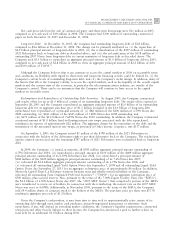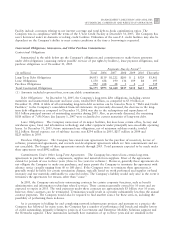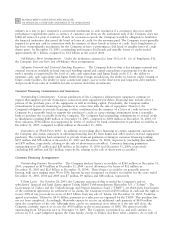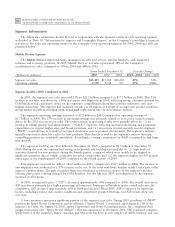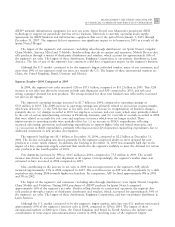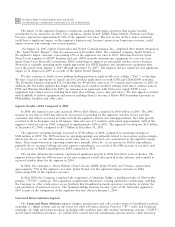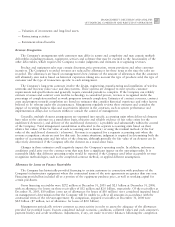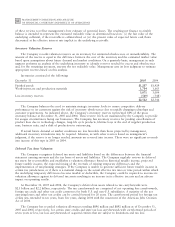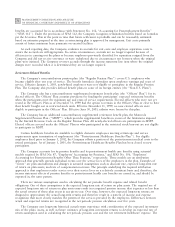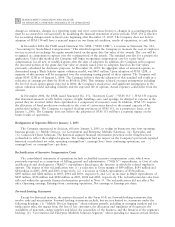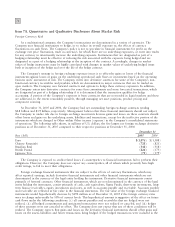Motorola 2005 Annual Report Download - page 71
Download and view the complete annual report
Please find page 71 of the 2005 Motorola annual report below. You can navigate through the pages in the report by either clicking on the pages listed below, or by using the keyword search tool below to find specific information within the annual report.
64 MANAGEMENT'S DISCUSSION AND ANALYSIS
OF FINANCIAL CONDITION AND RESULTS OF OPERATIONS
The nature of the segment's business is long-term contracts with major operators that require sizeable
investments by its customers. In 2005, five customersÌSprint Nextel; KDDI; China Mobile; Verizon; and China
UnicomÌrepresented approximately 56% of the segment's net sales. The loss of one of these major customers
could have a significant impact on the segment's business and, because contracts are long-term in nature, could
impact revenue and earnings over several quarters.
On August 12, 2005, Sprint Corporation and Nextel Communications, Inc. completed their merger transaction
(the ""Sprint Nextel Merger'') that was announced in December 2004. The combined company, Sprint Nextel, is
the segment's largest customer, representing 25% of the segment's net sales in 2005. Motorola has been Sprint
Nextel's sole supplier of iDEN» handsets and core iDEN network infrastructure equipment for over ten years.
Sprint Nextel uses Motorola's proprietary iDEN technology to support its nationwide wireless service business.
Motorola is currently operating under supply agreements for iDEN handsets and infrastructure equipment that
cover the period from January 1, 2005 through December 31, 2007. The segment did not experience any significant
impact to its business in 2005 as a result of the Sprint Nextel Merger.
We also continue to build on our industry-leading position in push-to-talk over cellular (""PoC'') technology.
We have executed agreements to launch our PoC product application on both GSM and CDMA2000 networks.
The Networks business deployed PoC technology for 44 wireless carriers in 33 countries and territories in 2005. In
addition, the Networks segment has begun executing on its seamless mobility strategy with major contract wins in
PON and Wireless Broadband. In 2005, we announced an agreement with Verizon to supply FTTP access
equipment and related services enabling their triple play offering (voice, data and video). We also signed a contract
with Earthlink to deliver equipment and services enabling them to become a Metro WiFi broadband provider in
Philadelphia, Anaheim and other cities.
Segment ResultsÌ2004 Compared to 2003
In 2004, the segment's net sales increased 24% to $6.0 billion, compared to $4.8 billion in 2003. The 24%
increase in net sales in 2004 was driven by an increase in spending by the segment's wireless service provider
customers and reflects increased net sales in both the segment's mature and emerging markets. Net sales growth
occurred in all technologies and in all regions. Sales into non-U.S. markets represented approximately 66% of the
segment's total net sales in 2004, compared to approximately 63% in 2003. The segment's backlog was $2.0 billion
at December 31, 2004, compared to $1.7 billion at December 31, 2003.
The segment's operating earnings increased to $718 million in 2004, compared to operating earnings of
$148 million in 2003. The 385% increase in operating earnings was primarily related to an increase in gross margin,
which was due to: (i) the 24% increase in net sales, and (ii) continued cost containment in the segment's supply
chain. These improvements in operating results were partially offset by: (i) an increase in SG&A expenditures,
primarily due to increased selling and sales support expenditures, as a result of the 24% increase in net sales, and
(ii) an increase in R&D expenditures in 2004 compared to 2003.
The wireless infrastructure industry experienced significant growth in 2004 after three years of decline. The
segment believes that the 24% increase in net sales outpaced overall sales growth in the industry, and resulted in
increased market share for the segment in 2004.
In 2004, five customersÌChina Mobile; China Unicom; KDDI; Sprint Nextel; and VerizonÌrepresented
approximately 55% of the segment's net sales. Sprint Nextel was the segment's largest customer in 2004,
representing 22% of the segment's net sales.
In May 2004, the Company completed the acquisition of Quantum Bridge, a leading provider of fiber-to-the-
premise (""FTTP'') solutions. The acquisition complements Motorola's existing multiservice technology, enabling
the Company to offer a full-service access platform that broadband network operators can deploy to deliver the
next generation of advanced services. The Quantum Bridge business became a part of the Networks segment in
2005 as part of the realignment of the segments that was effective January 1, 2005.
Connected Home Solutions Segment
The Connected Home Solutions segment designs, manufactures and sells a wide variety of broadband products,
including: (i) digital systems and set-top boxes for cable television, Internet Protocol (""IP'') video and broadcast
networks, (ii) high speed data products, including cable modems and cable modem termination systems (""CMTS'')
and IP-based telephony products, (iii) hybrid fiber coaxial network transmission systems used by cable television



